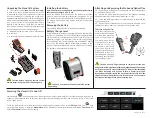
M19-354
Page 16
©
2019 AMETEK Brookfield Inc. All rights reserved.
IV. DETERMINATION OF THE NON-NEWTONIAN BEHAVIOR
Non-Newtonian behavior can be determined when different measurement times are recorded
with repeated tests.
IV.1 Thixotrophy/Rheopexy
Thixotropy (rheopexy) is indicated if the traveling times for a ball decreases (increases) when
repeated measurements are made on the same volume of sample.
NOTE:
If temperature control is not done correctly, thixotropy or rheopexy can be
inferred by mistake.
Rotational or Capillary Viscometers should be used for better determination of flow behavior.
IV.2 Structural Viscosity (Pseudoplasticity and Dilatancy)
Using the KF40 Falling Ball Viscometer at different angles may serve to determine pseudoplastic
or dilatant behavior for non-Newtonian liquids. If the sample is non-Newtonian, the travel time
of the ball multiplied by the sine of the working angle for the KF40 will not remain constant.
This infers non-Newtonian flow behavior. For pseudoplasticity, the calculated value decreases;
for dilatancy, it increases.
NOTE:
If temperature control is not done correctly, pseudoplasticity or dilatancy can be
inferred by mistake.
Details about the relative values for pseudoplasticity and dilatancy are related to the diameter
of the ball and the working angle.
More sophisticated equipment, like rotational viscometers/rheometers, should be used for
detailed examination of non-Newtonian materials.





































